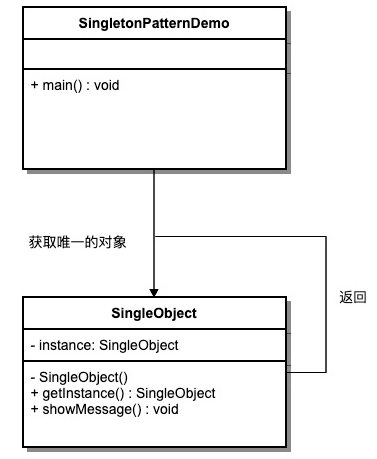软件设计模式中的最简单的设计模式的实现,主要是应用在线程池中。分为单例模式介绍、线程池实现两部分
1 单例模式
单例模式(Singleton Pattern)是软件设计模式中最简单的设计模式之一。这种类型的设计模式属于创建型模式,它提供了一种创建对象的最佳方式。
这种模式涉及到一个单一的类,该类负责创建自己的对象,同时确保只有单个对象被创建。这个类提供了一种访问其唯一的对象的方式,可以直接访问,不需要实例化该类的对象。
单例模式是一种创建型设计模式,它确保一个类只有一个实例,并提供了一个全局访问点来访问该实例。
注意:
1、单例类只能有一个实例。
2、单例类必须自己创建自己的唯一实例。
3、单例类必须给所有其他对象提供这一实例。
单例模式图如下:

简要的示例如下:
- 懒汉版:单例实例在第一次被使用时才进行初始化,这叫做延迟初始化。
1
2
3
4
5
6
7
8
9
10
11
12
13
14
15
16
17
18
19
20
21
|
class Singleton
{
private:
static Singleton* instance;
private:
Singleton() {};
~Singleton() {};
Singleton(const Singleton&);
Singleton& operator=(const Singleton&);
public:
static Singleton* getInstance()
{
if(instance == NULL)
instance = new Singleton();
return instance;
}
};
Singleton* Singleton::instance = NULL;
|
但是这样做有内存泄漏的问题,有两种解决办法:
- 智能指针
- 静态的嵌套类的对象
1
2
3
4
5
6
7
8
9
10
11
12
13
14
15
16
17
18
19
20
21
22
23
24
25
26
27
28
29
30
31
|
class Singleton
{
private:
static Singleton* instance;
private:
Singleton() { };
~Singleton() { };
Singleton(const Singleton&);
Singleton& operator=(const Singleton&);
private:
class Deletor {
public:
~Deletor() {
if(Singleton::instance != NULL)
delete Singleton::instance;
}
};
static Deletor deletor;
public:
static Singleton* getInstance() {
if(instance == NULL) {
instance = new Singleton();
}
return instance;
}
};
Singleton* Singleton::instance = NULL;
Singleton::Deletor Singleton::deletor;
|
- 饿汉版
1
2
3
4
5
6
7
8
9
10
11
12
13
14
15
16
17
18
|
class Singleton
{
private:
static Singleton instance;
private:
Singleton();
~Singleton();
Singleton(const Singleton&);
Singleton& operator=(const Singleton&);
public:
static Singleton& getInstance() {
return instance;
}
}
Singleton Singleton::instance;
|
2 在线程池中实现单例模式
1
2
3
4
5
6
7
8
9
10
11
12
13
14
15
16
17
18
19
20
21
22
23
24
25
26
27
28
29
30
31
32
33
34
|
template <typename T>
class threadpool
{
private:
static threadpool* instance;
public:
static threadpool* getInstance() {
if(instance == NULL)
instance = new threadpool();
return instance;
}
bool append(T *request, int state);
bool append_p(T *request);
private:
threadpool(int actor_model, connection_pool *connPool, int thread_number = 8, int max_request = 10000);
~threadpool();
private:
static void *worker(void *arg);
void run();
private:
int m_thread_number;
int m_max_requests;
pthread_t *m_threads;
std::list<T *> m_workqueue;
locker m_queuelocker;
sem m_queuestat;
connection_pool *m_connPool;
int m_actor_model;
};
|
感谢看到这里,在记录中收获成长,道阻且长
